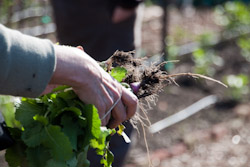We all know the idiom “you reap what you sow”, however home vegetable gardening involves more than just sowing seed and then harvesting the crop. Between the sowing and reaping is a good deal of monitoring, watering, fertilizing, controlling pests and weeds, etc. Initially the garden must be planned, soil and irrigation system prepared, and which crops to grow must be carefully considered to make the most efficient use of space and to allow for the growth of both cool- and warm-season crops in the same physical space. Planning also minimizes the reuse of the same beds for the same crops, which reduces disease.
If a vegetable garden is to produce a lot of food, it must be planned and prepared carefully. The site should be as level as possible, fully sunlit (at least 8 hours per day), with good drainage and good soil. If the land is sloped, the rows should be arranged across the slope, not up and down the slope, to minimize water runoff and erosion. Any tall, trellised crops that might cast shade should be placed on the north border of the garden. Tall trees, fences, and buildings that cast shade should be factored into the plan. Deciduous trees will cast shade only part of the year and beds near these trees can be used when the trees are barren, or the shade could be used to protect crops like lettuce or spinach in late spring/early summer.
Soil should be double-dug by hand, incorporating as much organic matter and compost as possible, or if soil quality or drainage is very poor, raised beds are an option. Don’t compact soil by walking on it. Don’t work the soil when it is too wet or too dry. Plan walkways between the rows that are wide enough to allow you to work comfortably.
Most of the vegetables are of the cool-season type, which thrive when average temperatures range from 55 - 75ºF. These tend to be true vegetables, that is, consisting of leaves, stems, roots or flower parts like cabbage, lettuce, carrots, turnips, broccoli, Swiss Chard, etc. Warm-season vegetables thrive when temperatures range from 65 - 95ºF, and are actually mature or immature fruits or seeds, like tomatoes, beans, squash, melon, and peppers. Cool-season vegetables have greater food value than warm-season vegetables. Warm-season vegetables are generally easier to grow because they are annual plants or perennials grown as annuals, whereas cool-season vegetables are usually biennials, which have a more complex life cycle. All biennial crops will flower (bolt) if they receive enough chilling during cold weather (a process called vernalization), and once bolted the root, stem, or leaf organs are generally no longer usable. Biennials must be planted early enough to allow the desired plant organ to grow to full size before vernalization occurs. Spring plantings generally occur in December or January, and fall plantings are started in summer. Transplants are rarely available in nurseries in the summer for the planting of fall biennial crops, so growing from seed is usually necessary. Biennial crops include all cole crops, carrots, parsley, celery, parsnips, beets, Swiss Chard, and onions. Broccoli is somewhat easier to grow as the flowers are the desired product.
Mulching the crops is important for reducing water loss and weeds. Woven plastic and organic mulches are commonly used, however organic mulches can harbor insects and other invertebrates that can damage young seedlings so are best used on established plantings. Be sure to weed regularly so that your young plants aren’t competing with weeds for moisture and nutrients. Pulling weeds before they go to seed will reduce future weed populations and save work in the long run.
Keeping records of the planting dates for crops and the varieties grown is very important, and will allow you to customize the crop selection and scheduling for your particular area. Keeping track of which beds held which crop is also important because we want to rotate the crops as much as possible to prevent buildup of pathogens.
Further Reading:
Growing Tomatoes in the Home Garden
(PDF)


